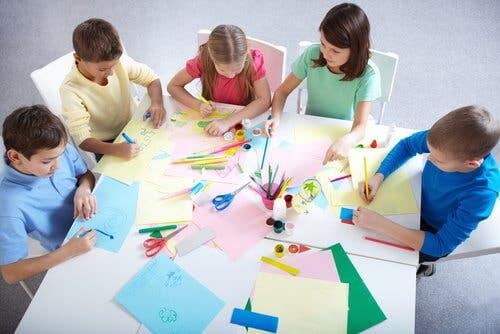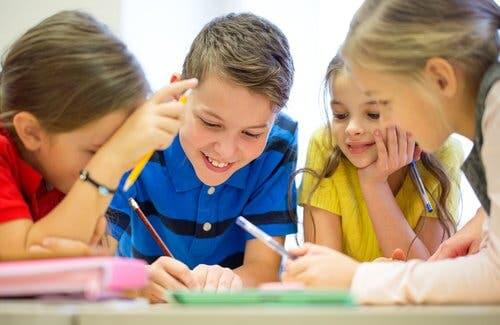Research Projects as a Learning Tool

Today, teachers need to move away from traditional teaching methods. In doing so, they must also educate themselves in order to implement innovative methodologies in the classroom. That way, they can pass on their knowledge in fun and dynamic ways. With that in mind, a good way to do so is to assign research projects as a learning tool.
With this educational technique, students can assimilate new content as they compile and analyze information. As a result, they learn based on discovery – by making mistakes and solving the problems they encounter.
“To give a child liberty is not to abandon him to himself. We discovered that education is not something which the teacher does, but that it is a natural process which develops spontaneously in the human being.”
– Maria Montessori –
Research projects as a learning tool
Assigning research projects as a learning tool is a good way to enrich any curriculum and benefit all of your students. This innovative methodology consists of giving children the task of conducting research. You can allow them to choose the subject, or you can assign specific topics that you’ve already explained in class.
So, based on questions and concrete problems, children must conduct an exhaustive search for information. To do so, they can use a wide variety of resources, such as:
- Textbooks.
- Internet.
- Informational programs.
- Magazines.
- The news.
- Images.
- Videos.
- Firsthand interviews.

What’s more, students must select, analyze, and synthesize the information they find. These processes require the use of critical, systematic, and logical thought. Therefore, we can say that assigning research projects as a learning tool helps students acquire knowledge and basic skills. And, in turn, it teaches them to solve problems and perform complex tasks satisfactorily.
Types of research projects
To implement this methodology, there are two factors you need to determine beforehand. First, you must decide how much freedom children will have when it comes to choosing a subject matter. In addition, you need to decide how the realization of the project will take place:
- Guided research project. Here, the teacher assigns the project and provides instructions on how to carry it out. He or she also participates in the different stages, supervising and revising the entire process.
- Free research project. The teacher gives students the freedom to choose a project. What’s more, he or she does not guide or supervise the various phases of its creation.
- Individual vs. group projects. Depending on the situation, teachers or even students themselves can decide to work alone or in small groups. Both of these options are compatible with guided or free research projects.
“Research is to see what everybody else has seen, and to think what nobody else has thought.”
– Albert Szent-Gyorgyi –
Benefits of assigning research projects as a learning tool
Doing research projects in class offers many great benefits when it comes to the learning of students. These include the following, among others:
- The development of social abilities such as collaboration, cooperation, communication, negotiation, etc.
- An improved capacity to be autonomous and work as part of a team.
- Increased creativity.
- The assimilation of knowledge in a practical and entertaining way.
- Students learn to make decisions and manage their time.

- Increased motivation, participation, and willingness towards schoolwork.
- The establishment of interconnected and integrated relationships between the content studies in different disciplines.
- Children come to understand how to use the information they learn in the real world.
- The construction of their own knowledge.
- Increased problem-solving skills.
- Improves self-esteem and self-concept.
With all of this in mind, we can say that this model of teaching encourages the emotional, intellectual, and personal development of children. Therefore, learning doesn’t involve simply memorizing concepts and meeting the curriculum objects of the education program. Rather, it involves increasing the depth, extension, and interdisciplinarity of learning.
So, through this practice, children develop the basic competency of learning to learn. According to the Education and Training Commission of the European Union, learning to learn is:
“The capacity to proceed and persist and organize one’s own learning, which involves carrying out an effective control of time and information, individually and as a group.”
– Education and Training Commission of the European Union –
Today, teachers need to move away from traditional teaching methods. In doing so, they must also educate themselves in order to implement innovative methodologies in the classroom. That way, they can pass on their knowledge in fun and dynamic ways. With that in mind, a good way to do so is to assign research projects as a learning tool.
With this educational technique, students can assimilate new content as they compile and analyze information. As a result, they learn based on discovery – by making mistakes and solving the problems they encounter.
“To give a child liberty is not to abandon him to himself. We discovered that education is not something which the teacher does, but that it is a natural process which develops spontaneously in the human being.”
– Maria Montessori –
Research projects as a learning tool
Assigning research projects as a learning tool is a good way to enrich any curriculum and benefit all of your students. This innovative methodology consists of giving children the task of conducting research. You can allow them to choose the subject, or you can assign specific topics that you’ve already explained in class.
So, based on questions and concrete problems, children must conduct an exhaustive search for information. To do so, they can use a wide variety of resources, such as:
- Textbooks.
- Internet.
- Informational programs.
- Magazines.
- The news.
- Images.
- Videos.
- Firsthand interviews.

What’s more, students must select, analyze, and synthesize the information they find. These processes require the use of critical, systematic, and logical thought. Therefore, we can say that assigning research projects as a learning tool helps students acquire knowledge and basic skills. And, in turn, it teaches them to solve problems and perform complex tasks satisfactorily.
Types of research projects
To implement this methodology, there are two factors you need to determine beforehand. First, you must decide how much freedom children will have when it comes to choosing a subject matter. In addition, you need to decide how the realization of the project will take place:
- Guided research project. Here, the teacher assigns the project and provides instructions on how to carry it out. He or she also participates in the different stages, supervising and revising the entire process.
- Free research project. The teacher gives students the freedom to choose a project. What’s more, he or she does not guide or supervise the various phases of its creation.
- Individual vs. group projects. Depending on the situation, teachers or even students themselves can decide to work alone or in small groups. Both of these options are compatible with guided or free research projects.
“Research is to see what everybody else has seen, and to think what nobody else has thought.”
– Albert Szent-Gyorgyi –
Benefits of assigning research projects as a learning tool
Doing research projects in class offers many great benefits when it comes to the learning of students. These include the following, among others:
- The development of social abilities such as collaboration, cooperation, communication, negotiation, etc.
- An improved capacity to be autonomous and work as part of a team.
- Increased creativity.
- The assimilation of knowledge in a practical and entertaining way.
- Students learn to make decisions and manage their time.

- Increased motivation, participation, and willingness towards schoolwork.
- The establishment of interconnected and integrated relationships between the content studies in different disciplines.
- Children come to understand how to use the information they learn in the real world.
- The construction of their own knowledge.
- Increased problem-solving skills.
- Improves self-esteem and self-concept.
With all of this in mind, we can say that this model of teaching encourages the emotional, intellectual, and personal development of children. Therefore, learning doesn’t involve simply memorizing concepts and meeting the curriculum objects of the education program. Rather, it involves increasing the depth, extension, and interdisciplinarity of learning.
So, through this practice, children develop the basic competency of learning to learn. According to the Education and Training Commission of the European Union, learning to learn is:
“The capacity to proceed and persist and organize one’s own learning, which involves carrying out an effective control of time and information, individually and as a group.”
– Education and Training Commission of the European Union –
All cited sources were thoroughly reviewed by our team to ensure their quality, reliability, currency, and validity. The bibliography of this article was considered reliable and of academic or scientific accuracy.
- Área, N., Árias, F., Cañete, M. B., Espina, M. A., Fernández, M. S., Pérez, L., Rodríguez, T. y Roiz, R. M. (2011). Adaptaciones curriculares de ampliación para alumnado con altas capacidades. Oviedo: Centro del Profesorado y de Recursos de Oviedo.
- Galeana, L. (n.d.). Aprendizaje basado en proyectos. México: Universidad de Colima.
This text is provided for informational purposes only and does not replace consultation with a professional. If in doubt, consult your specialist.








